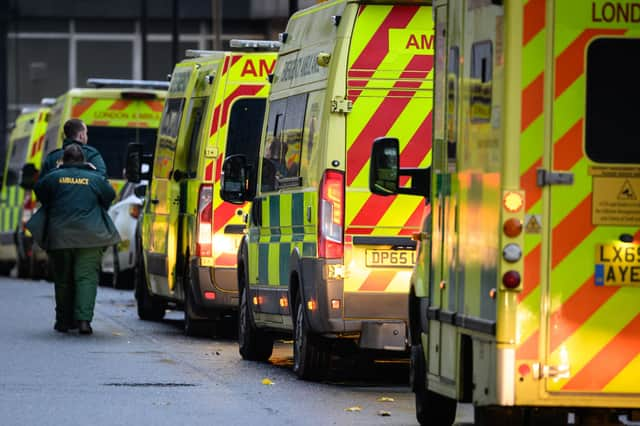What is patient flow? Statistics, challenges, and consequences of poor patient flow in the NHS

Image: Getty Images
What is patient flow?
Put simply, patient flow is the movement of patients through different departments and units in a hospital.
It encompasses the patient’s entire journey – from arrival and registration to being seen by staff, undergoing diagnostic tests and procedures, being admitted to or discharged from the hospital, and everything in between.
Efficient patient flow is crucial for hospitals to deliver high-quality, timely care. However, many NHS hospitals are currently struggling with patient flow challenges resulting in crowded emergency departments, long wait times, and patient dissatisfaction.
What is causing the current patient flow challenges in the NHS? – with statistics
Lack of social care capacity
One of the main challenges directly causing poor patient flow is the lack of adequate social care capacity, resulting in the delayed discharge of medically fit patients.
NHS England data for the month of October 2022 shows just 39.9% of patients were discharged when they were medically ready to be, with over 13,000 beds on an average day occupied by patients who could have been discharged1
Similarly, the lack of integration between health and social care is leading to delays in the discharge and handover of patients, resulting in the discharge process being disjointed and taking much longer than it needs to.
Ageing population and increased demand
The population is growing and ageing, which is naturally driving up demand for NHS services.
In 2019/20 there were 25.0 million attendances at A&E, compared to 21.5 million attendances in 2011/122
High bed occupancy in hospitals
High bed occupancy impacts patient flow, operational performance and waiting times, due to the difficulty of finding beds for patients. High bed occupancy is also known to increase infection rates, resulting in poorer outcomes.
Whilst there is no agreed standard for bed occupancy rates, the National Institute for Clinical Excellence (NICE) in 2018 recommended a ‘pragmatic maximum’ of 90%.
In 2019/20, overnight general and acute bed occupancy averaged 90.2% and regularly exceeded 95 per cent in winter, which is well above the 90% ‘maximum’3.
Staffing shortages
The latest NHS vacancy statistics from NHS Digital found that the total number of vacancies in September 2022 was 133,446, a vacancy rate of 9.7%. This represented an increase from the previous year when the number of vacancies was 103,809 and the vacancy rate was 7.9%4.
Almost all respondents who replied to a recent NHS Providers survey said that staff shortages are having a serious and detrimental impact on services and will hinder efforts to deal with those major care backlogs5.
Put simply, hospitals need more staff to be able to reduce delays and treat patients as quickly as possible, in view of increasing patient flow and increasing satisfaction in the NHS from staff, patients, and the general public.
Funding constraints
Tight budgets make it hard for NHS Trusts to increase permanent bed capacity both in the number of beds on their sites and in the actual size of their sites.
Funding constraints are also making it difficult for hospitals to expand their workforce and retain their current workforce with competitive salaries.
Consequences of poor patient flow in hospitals
Poor patient flow in hospitals has wide-reaching consequences, not just for hospitals and patients, but also for the whole healthcare system:
- ED crowding – When inpatient beds are lacking, patients back up in the ED, leading to longer waits for patients, slower ambulance handovers, and poorer outcomes.
- Delays in care and treatment – Patients waiting for beds most likely won’t be able to get needed tests, procedures, and surgeries on time, prolonging hospital stays and potentially worsening patients’ health conditions.
- Lower patient satisfaction – Long waits and delayed treatment will likely cause patient dissatisfaction which can impact the reputation of the hospital and the NHS as a whole.
- Staff burnout – Constant crowding and full occupancy in hospitals increase nurse fatigue and burnout, leading to poor job satisfaction and further exacerbating the current NHS staffing shortages.
- Slower ambulance response times in the community – Ambulance handover delays at ED departments reduce the emergency service’s capacity to respond to callouts in the community, leading to poor outcomes and increased pressure.
Citations
[1] https://www.nhsconfed.org/articles/social-care-patient-flow-and-elective-backlog
[2] https://www.kingsfund.org.uk/projects/urgent-emergency-care/urgent-and-emergency-care-mythbusters
[3] https://www.kingsfund.org.uk/publications/nhs-hospital-bed-numbers
[4] https://digital.nhs.uk/data-and-information/publications/statistical/nhs-vacancies-survey/april-2015—june-2022-experimental-statistics
[5] https://www.bmj.com/content/377/bmj.o945
Related articles
What are the benefits of early mobilisation in ICU and Hospitals?
How do patient stretchers improve efficiency and patient flow in hospitals?
How does the Felgains ImageFlow stretcher improve efficiency in imaging departments?
Get in touch
Got a question or want to send us a message? Let’s talk.